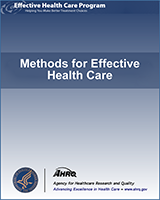NCBI Bookshelf. A service of the National Library of Medicine, National Institutes of Health.
Chou R, Ahmed AY, Iyer S, et al. Living Systematic Reviews: Examining Excluded Full-Text Articles To Better Understand the Evidence Base on Plant-Based Treatments for Chronic Pain [Internet]. Rockville (MD): Agency for Healthcare Research and Quality (US); 2024 Jan.

Living Systematic Reviews: Examining Excluded Full-Text Articles To Better Understand the Evidence Base on Plant-Based Treatments for Chronic Pain [Internet].
Show detailsChronic pain is difficult to treat successfully. A series of recent systematic reviews funded by the Agency for Healthcare Research and Quality (AHRQ)1–4 found that commonly used treatments, including opioids, nonopioid medications, and nonpharmacological interventions, are associated with limited efficacy in the long term and potential harms. In the case of opioids,5 serious potential harms include risk of opioid use disorder and overdose. Therefore, identifying new treatments for chronic pain that are effective and safe is an important clinical and public health priority.
Plant-based compounds (PBCs) such as cannabis and kratom are a potential treatment for chronic pain; however, their effectiveness and safety is uncertain. Given increasing legal access to cannabis and clinical and research interest in PBCs for treating chronic pain, an existing evidence base was available and publication of additional research was anticipated. Therefore, in 2020, AHRQ commissioned a “living” review6 spanning multiple years, in order to evaluate and regularly update the evidence base on cannabis and other PBCs with psychoactive properties, such as kratom, on chronic pain. Along with the living review, AHRQ commissioned a series of related white papers. The first white paper7 drew on experience of the first year of the living review8 and described practical and methodological considerations. The second white paper9 was primarily based on year two of the living review10 and focused on issues related to expanding scope and communication of findings.
For this third white paper, we sought to obtain additional insight into the larger evidence base on plant-based treatments for chronic pain, by examining articles that were selected for full-text review for potential inclusion in the living review but did not meet eligibility criteria, including the number of articles, types of studies, treatments evaluated, and reasons for exclusion.
- Background - Living Systematic Reviews: Examining Excluded Full-Text Articles To...Background - Living Systematic Reviews: Examining Excluded Full-Text Articles To Better Understand the Evidence Base on Plant-Based Treatments for Chronic Pain
Your browsing activity is empty.
Activity recording is turned off.
See more...